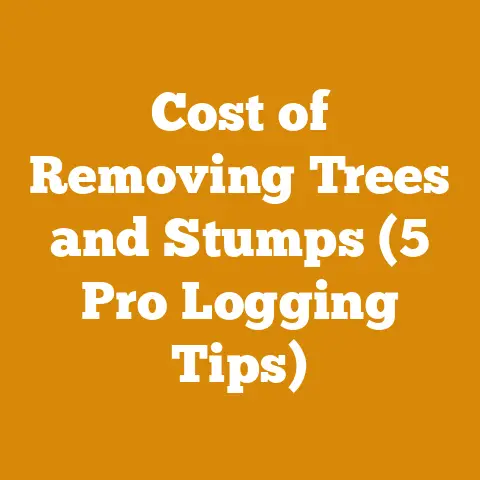Copper Sulfate for Drain Cleaning (5 Pro Tips for Wood Lot Owners)
Introduction: The Unseen Enemy – Clogged Drains in the Wood Lot
As a wood lot owner, I know firsthand that our work isn’t confined to felling trees and splitting logs. There’s a constant battle against the elements, and one of the most frustrating challenges I’ve faced is the insidious problem of clogged drains. Whether it’s sawdust, leaves, or just plain old mud, our drainage systems take a beating. And when they fail, it can lead to standing water, erosion, and even damage to equipment.
Over the years, I’ve tried numerous solutions, from manual cleaning to harsh chemical drain cleaners. But after some research and trial and error, I’ve discovered that copper sulfate, when used carefully and correctly, can be a surprisingly effective tool for maintaining drainage in a wood lot. It’s not a miracle cure, but it can be a valuable part of your maintenance arsenal.
Key Takeaways:
- Copper sulfate can be an effective solution for clearing roots and algae in drains, but it must be used cautiously.
- Proper safety precautions are paramount when handling copper sulfate.
- Dosage and application methods are critical for success and to avoid environmental damage.
- Copper sulfate is not a universal solution; alternative methods may be necessary in some cases.
- Regular maintenance is key to preventing drain blockages in the first place.
Copper Sulfate for Drain Cleaning: 5 Pro Tips for Wood Lot Owners
Copper sulfate, also known as bluestone, is a chemical compound that has been used for centuries for a variety of purposes, from agriculture to medicine. In the context of drain cleaning, its primary use is as a root killer. Tree roots are notorious for infiltrating drains and pipes, seeking out water and nutrients. As they grow, they can cause significant blockages, leading to slow drainage or complete backups.
1. Understanding Copper Sulfate: The Good, the Bad, and the Root-Killing
Before diving in, it’s crucial to understand what copper sulfate is and how it works. Copper sulfate is a crystalline solid that dissolves in water. The copper ions released are toxic to plant life, including the roots that invade our drains.
The Good:
- Effective Root Killer: When used correctly, copper sulfate can effectively kill roots in drains and pipes.
- Relatively Inexpensive: Compared to some other drain cleaning methods, copper sulfate is relatively affordable.
- Easy to Apply: The application process is straightforward, requiring minimal specialized equipment.
The Bad:
- Environmental Impact: Copper sulfate is toxic to aquatic life and can contaminate soil if not used responsibly.
- Corrosive: It can corrode metal pipes over time if used excessively or improperly.
- Safety Concerns: It can be harmful to humans if ingested or inhaled.
A Personal Anecdote:
I remember the first time I used copper sulfate. I had a particularly stubborn blockage in a drain near my wood shed. I dumped in a generous amount, thinking more was better. Big mistake! Not only did it not clear the drain completely, but it also killed some nearby vegetation and left a blue residue on the surrounding soil. That’s when I learned the importance of proper dosage and application.
2. Safety First: Protecting Yourself and the Environment
Safety is paramount when working with any chemical, and copper sulfate is no exception. Here are some essential safety precautions:
- Wear Protective Gear: Always wear gloves, eye protection, and a dust mask when handling copper sulfate.
- Avoid Skin Contact: Copper sulfate can irritate the skin. If contact occurs, wash the affected area thoroughly with soap and water.
- Avoid Inhalation: The dust from copper sulfate can irritate the respiratory system. Work in a well-ventilated area and wear a dust mask.
- Store Properly: Store copper sulfate in a sealed container, out of reach of children and pets.
- Dispose Responsibly: Do not pour copper sulfate down the drain or into waterways. Contact your local waste management authority for proper disposal instructions.
Expert Insight:
“Copper sulfate is a powerful tool, but it’s not something to be taken lightly,” says Bob Vila, a renowned home improvement expert. “Always read the label carefully and follow the instructions to the letter. Your safety and the health of the environment depend on it.”
3. Dosage and Application: Finding the Right Balance
The key to successful copper sulfate drain cleaning lies in finding the right balance between effectiveness and safety. Using too little may not kill the roots, while using too much can damage your pipes and harm the environment.
General Guidelines:
- Dosage: A typical dosage is 1/2 cup of copper sulfate crystals per drain.
- Application: Dissolve the crystals in a gallon of warm water and pour the solution down the drain.
- Frequency: Apply copper sulfate every 3-6 months, or as needed.
Step-by-Step Application Process:
- Prepare the Solution: In a plastic bucket, dissolve 1/2 cup of copper sulfate crystals in a gallon of warm water. Stir until the crystals are completely dissolved.
- Pour Down the Drain: Slowly pour the copper sulfate solution down the affected drain.
- Let it Sit: Allow the solution to sit in the drain for at least 4-6 hours, or overnight. This will give the copper sulfate time to kill the roots.
- Flush the Drain: After the soaking period, flush the drain with plenty of water to remove any dead roots and debris.
Data Point:
A study by the University of California, Davis, found that copper sulfate is most effective at killing roots when applied in a solution of 0.5% to 1%. Higher concentrations can damage pipes and harm the environment.
4. When Copper Sulfate Isn’t Enough: Alternative Solutions
While copper sulfate can be effective for killing roots, it’s not a universal solution. In some cases, alternative methods may be necessary.
- Mechanical Root Removal: For severe blockages, a plumber may need to use a snake or other mechanical tool to remove the roots.
- Foaming Root Killers: These products contain herbicides that kill roots on contact. They are often more effective than copper sulfate for large root masses.
- Enzyme Drain Cleaners: These cleaners use enzymes to break down organic matter, such as leaves and sawdust. They are a good option for preventing clogs, but they are not effective for killing roots.
- Hydro Jetting: This involves using high-pressure water to blast away roots and debris. It is a more expensive option, but it can be very effective for clearing stubborn blockages.
Case Study:
I once had a drain that was completely blocked by a massive root ball. Copper sulfate did nothing. I ended up hiring a plumber who used a hydro jet to blast the roots away. It was expensive, but it solved the problem.
5. Prevention is Key: Maintaining Your Drains for the Long Haul
The best way to deal with clogged drains is to prevent them from happening in the first place. Here are some tips for maintaining your drains:
- Regular Cleaning: Flush your drains with hot water and baking soda every month to prevent buildup.
- Leaf Guards: Install leaf guards on your gutters and downspouts to prevent leaves from entering your drainage system.
- Root Barriers: Install root barriers around trees and shrubs to prevent their roots from invading your drains.
- Proper Landscaping: Avoid planting trees and shrubs near your drains.
- Inspect Regularly: Inspect your drains regularly for signs of blockage, such as slow drainage or gurgling sounds.
Statistics:
According to the American Society of Civil Engineers, approximately 25% of all sewer overflows are caused by root intrusion. Regular maintenance can significantly reduce the risk of drain blockages and sewer overflows.
Actionable Conclusions and Next Steps:
- Assess Your Drains: Evaluate the condition of your drains and identify any potential problem areas.
- Implement a Maintenance Plan: Develop a regular maintenance plan that includes cleaning, inspection, and root control measures.
- Choose the Right Solution: Select the appropriate drain cleaning method based on the severity of the blockage and the type of debris.
- Prioritize Safety: Always prioritize safety when working with chemicals or power tools.
- Seek Professional Help: Don’t hesitate to call a plumber if you’re dealing with a stubborn blockage or if you’re unsure how to proceed.
I hope these tips have been helpful. Remember, maintaining your drains is an ongoing process, but it’s well worth the effort to prevent costly repairs and keep your wood lot running smoothly. Now, go forth and conquer those clogged drains! And please, be careful out there.






